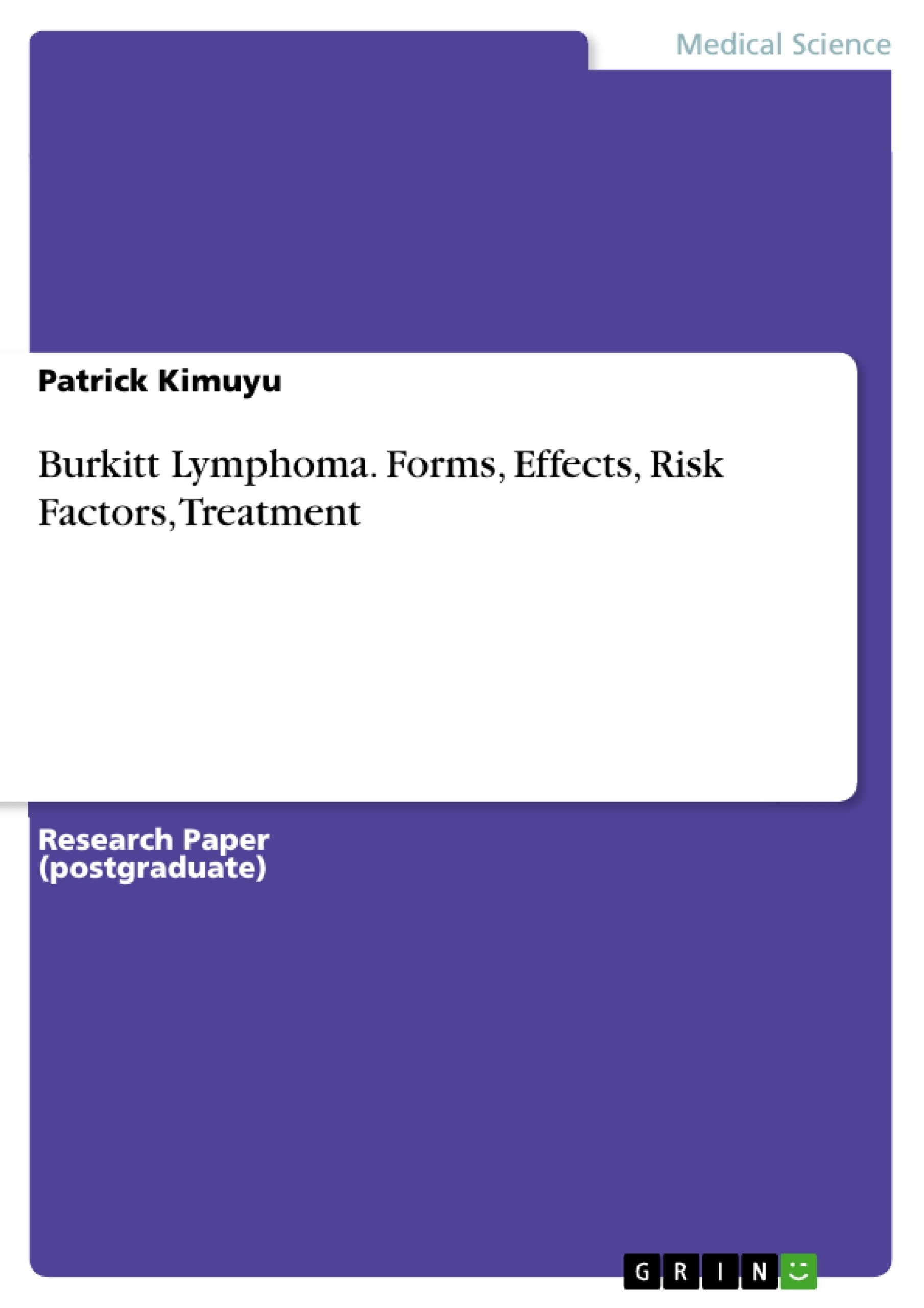This research paper will provide an overview on Burkitt lymphoma disease and its pathophysiology.
Burkitt lymphoma has become one of the most prevalent cancers in the past two decades in which the number of people with the disease has increased, especially in Africa. Research indicates that burkitt lymphoma has emerged to be the fastest growing tumor among humans.
Burkitt lymphoma was identified in 1956 by Denis Burkitt, and it is one of the principal forms on non-Hodgkin’s lymphoma, which affect immune cells. Epidemiological reports indicate that, Burkitt lymphoma is more prevalent in malaria endemic regions than other regions although it greatest impact is experienced in Africa where it affects children who are also experiencing episodes of malaria and Epstein-Barr viral infection. Epstein-Barr virus is believed to be the principal cause of infectious mononucleosis, which leads to the transformation of B-cells into tumor cells, especially following malaria episode which weakens the immune system. This is probably the reason as to why 98% of Burkitt lymphoma cases in Africa are linked to Epstein-Barr infection. Elsewhere in the U.S, the incidence of Burkitt lymphoma accounts for about 1,200 people annually in which 59% of all the patients diagnosed with the disease being adults above the age of 40 years.
In Burkitt lymphoma, lymphocytes, primarily the B-cells of the immune system which are involved in cell-mediated immune response during pathogenic infections are affected. In most cases, the prevalence of the disease is enhanced by infections which weaken the immune system. For instance, malaria, Epstein-Barr viral infection and HIV are some of the diseases associated with a decrease of the immune system response. In addition, therapies which are immune-suppressive, especially those involved in organ transplantation to prevent transplant rejection and highly-active antiretroviral therapy (HAART) used for HIV/AIDS treatment facilitate the formation of cancerous B-cells. However, the physiology and anatomy of Burkitt lymphoma encompasses diverse aspects compared to other forms cancer.
Table of Contents
- Summary
- Introduction
- Forms of Burkitt Lymphoma and their Effects on Body Physiology
- Anatomical Regions Affected by Burkitt Lymphoma
- Risk Factors of Burkitt Lymphoma
- Pathophysiology
- Physiological Effects of Burkitt Lymphoma Symptoms
- Treatment of Burkitt Lymphoma: How Therapies Affect Physiology
Objectives and Key Themes
This research paper provides a comprehensive overview of Burkitt lymphoma, a prevalent cancer with a significant impact, particularly in Africa. The paper explores the various forms of Burkitt lymphoma, their physiological effects, and the underlying mechanisms of the disease.
- The different forms of Burkitt lymphoma and their prevalence trends.
- The anatomical regions and organs affected by the disease.
- Key risk factors associated with Burkitt lymphoma development.
- The role of oncogenes and suppressor genes in the pathophysiology of Burkitt lymphoma.
- The impact of various therapies on the physiology of patients with Burkitt lymphoma.
Chapter Summaries
The paper begins by introducing Burkitt lymphoma, highlighting its increasing prevalence, particularly in Africa. It emphasizes the role of infectious agents like Epstein-Barr virus and malaria in weakening the immune system and contributing to the development of the disease.
The paper then delves into the different forms of Burkitt lymphoma, including sporadic, endemic, and immunodeficiency-related types. Each form exhibits distinct geographical distribution, prevalence trends, and etiological factors. Sporadic Burkitt lymphoma is found globally, while endemic Burkitt lymphoma is predominantly observed in equatorial Africa. Immunodeficiency-related Burkitt lymphoma occurs in individuals with suppressed immunity, particularly HIV/AIDS patients and organ-transplant recipients.
The paper further explores the anatomical regions affected by Burkitt lymphoma, emphasizing the involvement of lymphoid tissues, particularly those found in organs like lymph nodes, jaw, facial bone, and the gastrointestinal tract.
The paper examines various risk factors associated with Burkitt lymphoma, including age, gender, immune system deficiencies, infections, and exposure to certain chemicals. The underlying mechanisms behind some of these risk factors remain unknown.
The paper concludes by discussing the pathophysiology of Burkitt lymphoma, highlighting the crucial roles of oncogenes and suppressor genes in DNA alterations observed in the disease. Oncogenes accelerate cell division, while suppressor genes control cell death. Imbalances in these processes can lead to uncontrolled cell proliferation and tumor formation.
Keywords
Burkitt lymphoma, non-Hodgkin's lymphoma, B-cells, immune system, Epstein-Barr virus, malaria, HIV/AIDS, oncogenes, suppressor genes, pathophysiology, endemic, sporadic, immunodeficiency-related.
- Quote paper
- Patrick Kimuyu (Author), 2017, Burkitt Lymphoma. Forms, Effects, Risk Factors, Treatment, Munich, GRIN Verlag, https://www.grin.com/document/381285




